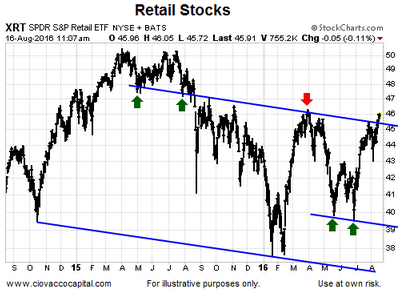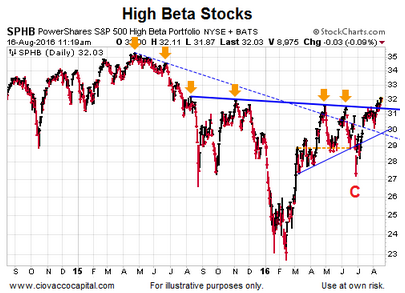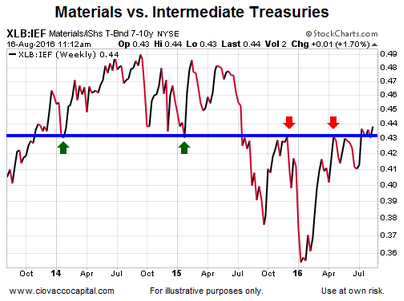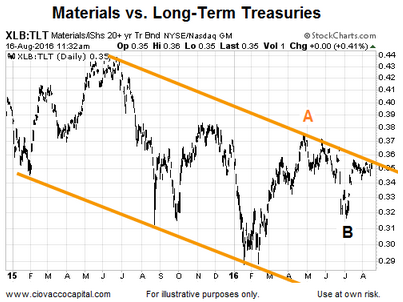
Retail Trying To Break Out
The consumer is often referred to as the lifeblood of the U.S. economy. Even though retail is in a state of Amazon-flux, the sector is trying to clear an area that has previously been dominated by sellers.

High Beta Clearing Hurdles
The High Beta ETF (SPHB) carries dominant weights in financials (XLF), energy (XLE), and technology (XLK). As shown in the chart below, this economically-sensitive investment is trying to break above an area that has acted as resistance for a year. As recently as June 28 (point C below), SPHB looked to be on the ropes.

Materials: One Hurdle Down
When investors are more confident about future market outcomes, they tend to prefer economically-sensitive materials (XLB) over defensive-oriented intermediate-term Treasury bonds (IEF). As shown in the chart below, the confident vs. concerned ratio is trying to break out in a confident manner.

Materials: One Hurdle To Go
Materials have some work to do relative to longer-term Treasury bonds (TLT). Both XLB and TLT are in positive trends when viewed in isolation. The ratio below helps us monitor the market’s tolerance for risk; it also gives us some insight into longer-term interest rate expectations. The market believes one more Fed hike could be coming in the next six months, but has doubts about a third hike ever seeing the light of day.

While risk tolerance has picked up since the June 28 Brexit reversal, the last time materials made a new high relative to long-term bonds was back in late April (point A above); the last new low was made in June (point B).
How Can We Use All This?
The charts above show an increasing tolerance for risk, which improves the odds of the S&P 500’s recent bullish break to new highs being sustainable. These charts can also be used to monitor any shifts in investor expectations about the markets, economy, and central bank policy.
It should also be noted the recent bullish pops higher on the charts of XRT (retail), SPHB (high beta), and XLB (materials) vs. IEF (bonds) are still near areas of prior resistance, meaning those breakouts still need to prove they can be sustained. The longer a breakout holds the more meaningful it becomes. The current bullish slant of the charts above aligns with the recent comparison of the market peaks in 2000 and 2007 to the present day.
This entry was posted on Tuesday, August 16th, 2016 at 11:43 am and is filed under Stocks - U.S.. You can follow any responses to this entry through the RSS 2.0 feed. Both comments and pings are currently closed.
Copyright © 2016 Ciovacco Capital Management, LLC. All Rights Reserved. Chris Ciovacco is the Chief Investment Officer for Ciovacco Capital Management, LLC (CCM). Terms of Use. This article contains the current opinions of the author but not necessarily those of CCM. The opinions are subject to change without notice. This article is distributed for informational purposes only and should not be considered as investment advice or a recommendation of any particular security, strategy or investment product. The charts and comments are not recommendations to buy or sell any security. Market sectors and related ETFs are selected based on his opinion as to their importance in providing the viewer a comprehensive summary of market conditions for the featured period. Chart annotations are not predictive of any future market action rather they only demonstrate the opinion of the author as to a range of possibilities going forward. All material presented herein is believed to be reliable but we cannot attest to its accuracy. The information contained herein (including historical prices or values) has been obtained from sources that Ciovacco Capital Management (CCM) considers to be reliable; however, CCM makes no representation as to, or accepts any responsibility or liability for, the accuracy or completeness of the information contained herein or any decision made or action taken by you or any third party in reliance upon the data. Some results are derived using historical estimations from available data. Investment recommendations may change and readers are urged to check with tax and investment advisors before making any investment decisions. Opinions expressed in these reports may change without prior notice. This memorandum is based on information available to the public. No representation is made that it is accurate or complete. This memorandum is not an offer to buy or sell or a solicitation of an offer to buy or sell the securities mentioned. The investments discussed in this report may be unsuitable for investors depending on their specific investment objectives and financial position. Past performance is not necessarily a guide to future performance. The price or value of the investments to which this report relates, either directly or indirectly, may fall or rise against the interest of investors. All prices and yields contained in this report are subject to change without notice. This information is based on hypothetical assumptions and is intended for illustrative purposes only. PAST PERFORMANCE DOES NOT GUARANTEE FUTURE RESULTS. CCM would like to thank StockCharts.com for helping Short Takes create great looking charts Short Takes is proudly powered by WordPress . Entries (RSS)